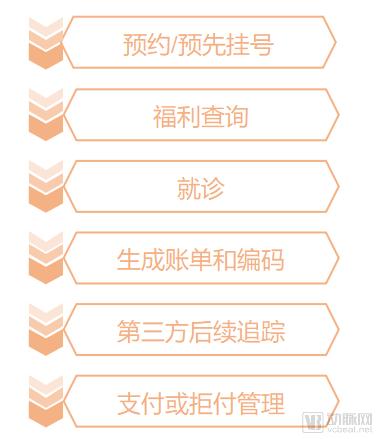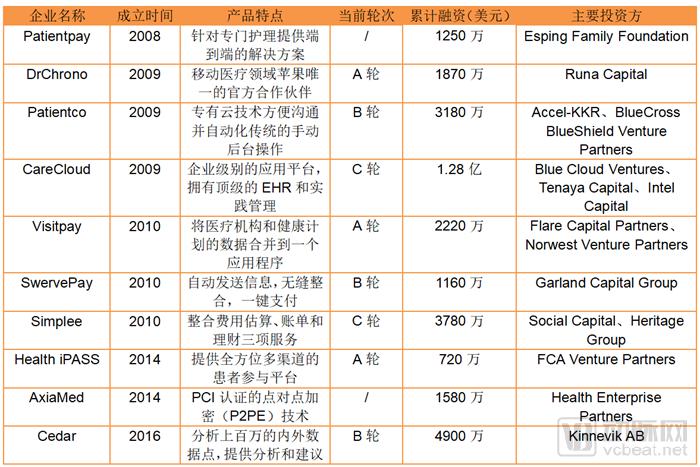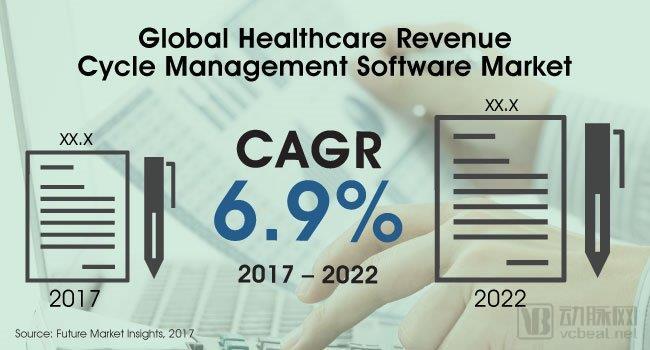Medical care is one of the most important industries in the United States, and its medical expenditures account for about 18% of GDP, much higher than other developed countries. Research shows that among US health care providers, patient payments account for 35% of the total, second only to Medicare and Medicaid. However, complex medical bills and rising patient self-pay ratios have become obstacles to medical payments, which has created opportunities for innovation.
The Arterial Network counted 10 US-innovated companies to analyze the revenue cycle management (RCM) issues behind the bills and the development trends in the payment market through their medical payment platforms.
Medical + Internet Payment Platform: An Effective Solution for RCM
When it comes to medical billing and payment, you have to mention the concept of RCM: Revenue Cycle Management. The Healthcare Enterprise Management Association (HBMA) defines RCM as “the process of managing reimbursement, payments, and generating revenue.†Revenue cycle management begins with the patient seeking medical care from the provider, ending with the completion of all reimbursement and payment. Medical organizations must follow these basic steps:

To some extent, RCM is the economic lifeblood of medical organizations. The current US healthcare revenue cycle market is worth about $50 billion, and is likely to grow to $90 billion over the next four years, and billing is at the heart of the entire revenue cycle management.
But a survey by the US Health Care Financial Management Association (HFMA) shows that healthcare organizations face many problems that prevent them from optimizing RCM. First, because the bills are too complex, the processing time can last for several months. Before the problem is solved, the bills often switch back and forth between the payer and the provider, and most patients cannot pay for the medical expenses in advance. Second, the lack of information makes it difficult for healthcare providers to deal with reimbursement issues. Finally, due to imperfections in the relevant systems, medical institutions are unable to determine which procedures require prior authorization for the patient's health plan.
Therefore, the ultimate goal of RCM is to create a process that allows medical institutions to charge for the service in the shortest amount of time. In addition, as hospitals and small healthcare organizations gradually shift to value-based service models, they need to develop policies and programs to address financial-related issues, namely, solutions for revenue cycle management.
A payment platform based on big data analytics and information technology is an effective solution for RCM. As the medical environment continues to improve, if a healthcare provider wants to continue to provide services to patients and generate revenue, it must ensure that the entire process is smooth. Healthcare organizations can reduce their concerns about revenue by building a platform that is centered on medical bills, and focus more on providing quality services to patients.
Given that most payments are related to value-based care models, healthcare organizations need to weigh the relationship between quality of care, patient satisfaction, and medical costs, which big data analysis can provide. In addition to managing large amounts of medical information , data analysis can help predict reimbursement results.
Information technology solutions have helped providers solve some of the common problems in RCM, such as ICD-10 code, communication between payers and providers, and medical billing processes. These solutions are equally applicable to value-based reimbursement and traditional service-based payment methods, which can benefit medical organizations that have not yet transitioned to the latest payment model. They can use these solutions to track reimbursement, payment processes, and resolve claims for reimbursement, resulting in stable and consistent revenue.
10 innovative companies in the US medical payment sector: diversified services

(Source: crunchbase, arterial network finishing)
In general, the medical payment platform generally includes the following basic functions and services in order to ensure that the medical service provider tracks every link in the entire cycle, solves the problems, and achieves effective bill payment and consistently stable income:
1. Personal information. The payment platform is combined with other systems to make the patient's personal information, including billing details, electronic health records, electronic medical records, etc. at a glance. It is convenient for patients to better manage, track and pay for their medical expenses.
2. Payment management. The payment platform provides secure and diverse payment options and automates the background processing.
3. Reimbursement management. Improve the entire collection process through technology while reducing denial or refusal of reimbursement. Healthcare organizations can also use the latest tools to train their employees on how to deal with denial or refusal of reimbursement.
4. Analysis and communication. By analyzing the data, the medical service provider provides advice and timely communication to the individual to help them solve the problems encountered in the payment process.
5. Customer relationship management. Through this system, medical institutions can manage patient participation, view patient's previous bills, monitor patients' financial behavior, track important indicators in time, and optimize all interactions with patients.
It can be seen that CareCloud is currently the leader in financing. Although it was established only ten years ago, it has become a major supplier of the global medical RCM market. CareCloud serves clinics, large medical institutions, corporations, medical startups, and specialists. Its solutions include revenue cycle management, practice management, electronic health records, patient experience, mobile APP, bill management, specialist care services, and healthcare analysis. Wait. Due to its high quality, multi-faceted services, CareCloud's products were ranked by Black Book as 2017 Practice Management Software and the first in the cloud-based Electronic Health Record (EHR) SaaS platform. Currently, CareCloud serves more than 4.5 million patients and manages accounts receivable for more than $2 billion.
In addition to CareCloud, Simplee and Patientco were early strong competitors. Simplee's financial software payment platform consists of three core products: Simplee estimates enable healthcare providers to build trust with customers from the very beginning; intelligent and coordinated communication through the Simplee wallet allows users to understand Their amount due and reason; Simele Money provides users with a more friendly financial option while reducing the financial burden on both users and healthcare providers. Simplee serves more than 900 US hospital and physician organizations, involving approximately 5 million patients, with annual bills paying more than $1 billion.
Patientco's SmartFinanceTM patient self-service financial management platform combines different financial products with Patientco's multi-channel consumer communication and payment tools. Healthcare organizations can use SmartFinance® to tailor financial solutions to different patient needs to speed patient payment and increase collection rates. Currently, the platform has 10 million patient users, serving more than 2,000 medical institutions across the United States, involving $1 billion in medical expenses.
Cedar, which was founded at the latest, is expected to become an emerging competitor in the mobile medical field, with products including a financial management platform for patients and a customer relationship management system for medical institutions. On behalf of its clients, Cedar, including one of the fastest growing multi-disciplinary joint practice platforms in the United States, has established contacts with nearly 100,000 patients across the country to help them complete tens of thousands of monthly medical bill payments. Through this platform, these medical institutions have increased their collection rate by 35%, the accounts receivable turnover days by 50%, customer satisfaction by 95%, and self-service payments by 60%.
Future trends in the RCM market: multi-driver, maintaining the current landscape
According to the report of Future Market Insights, it is estimated that by the end of 2022, the global medical revenue cycle management software market will reach 43.3 billion US dollars, and the compound annual growth rate (CAGR) will reach 6.9%.

As the cumulative medical expenses of patients continue to increase, the collection rate and settlement efficiency increase, and the profits generated by them are considerable. The report predicts that the market will show a positive growth trend in the next few years. The drivers of the RCM software market are as follows:
1. Medical codes are used to standardize clinical pathways and prices, simplifying the reimbursement process and are the basis for payment by payers. The RCM system will reduce the errors of medical service providers in this regard, enabling managers to improve efficiency and focus more on the rational allocation of medical resources. For example, in the United States, the medical coding process is unpredictable and boring, and this process can be optimized through the associated RCM solution.
2. Reduced reimbursement of medical services and increased refusal rates by government and private institutions will prompt a large number of social insurance providers to seek RCM solutions.
3. The government’s policy of controlling and controlling the medical field is constantly changing, resulting in an increase in operating costs and a decline in the income of medical institutions.
4. Relevant regulators will continue to monitor illegal installment payments for health insurance, which will further reduce their revenue. In order to maintain low operating costs, healthcare providers entrust revenue cycle management to external professional companies to improve their RCM systems.
5. RCM software can enhance the follow-up management of collections, and revenue in this area is expected to account for more than a quarter of global medical revenue.
6. Manual reimbursement management imposes administrative and regulatory burdens on RCMs in medical institutions.
On the technical side, cloud deployment will save on healthcare costs, increase the flexibility of RCM systems, and ensure connectivity among multiple users by enhancing resource acquisition, eliminating scalability constraints, improving infrastructure reliability, and consolidating the organization's operational framework. Transferability. In 2017, cloud-based medical RCM software generated nearly $27 billion in revenue. Given the complex structure of RCM, cloud deployment is also expected to save costs by coordinating actual usage and resource expenditures.
On the user side, the largest end users of RCM software are hospitals, followed by clinics and laboratories. In 2017, the lab contributed nearly one-fifth of global medical revenue, and the use of the clinic's RCM system is expected to generate nearly $6.5 billion in revenue.
Key partners in global medical payment software, such as Cerner, McKesson, Quest Diagnostics, Athenahealth, Epic Systems Corporation, EMC, Greenway Health LLC, Allscripts healthcare Solutions, etc., will focus on eliminating defects and increasing security measures in the future. To protect important data on its product management. In addition, “new players†may face obstacles when entering this highly competitive market.
China Mobile Medical Development Status: Government and Large Enterprises
Due to the difference between the medical system and the medical policy, the US-style medical billing and payment platform model is still in its infancy in China, and the mobile medical payment market is still occupied by the government and large enterprises.
In March 2017, the national medical settlement platform was officially launched, and the remote medical treatment settlement system was used as a cross-provincial medical data exchange center to undertake data exchange functions. As a cross-provincial medical fund clearing center, the statistical analysis system undertakes the functions of reconciliation, clearing and monitoring of medical expenses in different places. The inquiry service center and the collaborative management system serve as the inter-provincial medical data resource center, and undertake the information on the medical record of the insured person, the basic catalog information, the protocol organization information, the medical treatment and settlement payment information storage function, and the data analysis application.
In addition, both Alipay and WeChat launch related medical services based on their respective platforms, including appointment registration, online consultation, electronic social security card, electronic health record, bill inquiry, inspection report acquisition, social security inquiry and payment.
Alipay's “Future Hospital†program is divided into three phases: the first phase helps hospitals establish mobile medical services, builds a smart medical platform, and helps hospitals implement basic services such as registration, medical treatment, and payment. The second phase includes e-prescribing, medical insurance mobile payment, and commercial insurance direct payment. The third phase is to build a health management platform based on big data and cloud computing capabilities.
At present, Alipay's medical plan has already reached the second stage. Specific to each pilot, after the user generates an electronic social security card through Alipay binding, he can complete the medical insurance + self-paying payment through the mobile phone at the time of medical treatment; the medical insurance family account mutual aid function allows the user to transfer the medical insurance balance to family members and relatives; The consumption reminder function pushes each medical insurance consumption record to the user through the Alipay bill. In recent days, Alipay has introduced free medical gold to all users, with a maximum amount of 20,000 yuan.
The “Smart Healthcare†solution launched by WeChat has covered 362 cities in 33 provincial administrative regions. It mainly includes appointment registration, social security inquiry and payment, medical examination service, outpatient payment, vaccine service and other functions. Compared with Alipay, WeChat is more in the inter-provincial medical treatment and the new rural cooperative payment.
At present, the Chinese government adopts universal medical insurance consisting of urban workers' medical insurance, urban residents' medical insurance, and new rural cooperative medical insurance, and it is a pay-as-you-go medical insurance system based on social security. The US government-led social health insurance focuses on the Medicare and the vulnerable groups (Medicaid), and the medical insurance for the working population is provided by commercial insurance institutions. The whole system involves politics, medicine, insurance, and suffering. In addition, China's medical treatment model is a market-based medical procedure that is registered at any time. The United States is an appointment-based and administrative medical procedure, and most Americans have their own fixed health care doctors.
Different medical insurance systems and treatment models have led to different difficulties and ways of managing bills between China and the United States. Compared with China, the medical bills in the United States are complicated. Due to the multiple parties involved and the long processing time, the emergence of the medical payment platform can meet the needs of the market and solve the problem of the entire income cycle. Although China's demand gap in this area is small, the emergence of services such as medical treatment settlement and online medical insurance payment indicates that China is developing rapidly in mobile medical care. All parties are working to build a more robust medical system and improve patients. Experience and continuous development and innovation.
Our natural sweetener is extracting from natural plant. Like inulin powder, there are jerusalem artichoke and chicory sources. Monk fruit extract has sweetness of hundreds times than that of sugar. As natural food ingredient supplier, we also supply bulk sweetener like fructo-oligosaccharide, xylooligosaccharide, xylitol, sorbitol, Stachyose, D-Allose, erythritol, stevia extract powder which has very similar taste with sugar, we also accept blend customization of sweetener, please feel free to reach us for more if any interests!
Natural Sweentener,Inulin Powder,Bulk Sweetener,Monk Fruit Extract
YT(Xi'an) Biochem Co., Ltd. , https://www.ytlinkherb.com